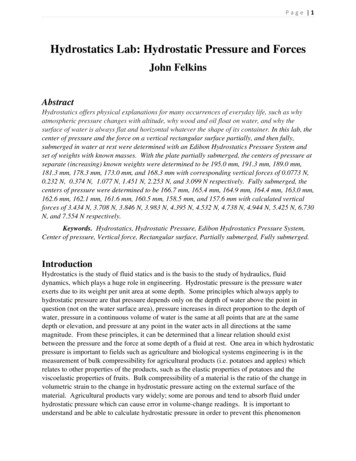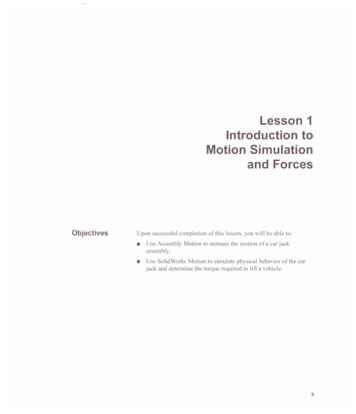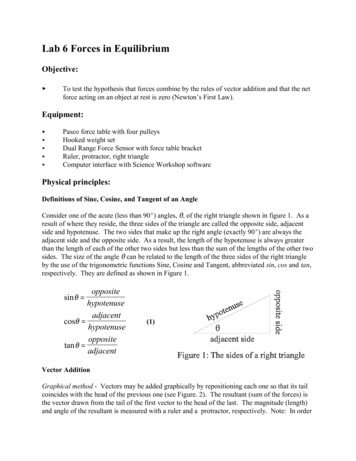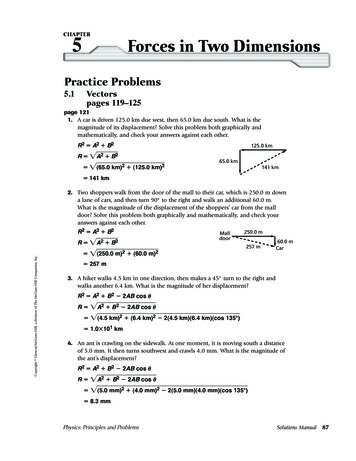
Transcription
Special Forces Assessment and SelectionPHYSICAL TRAININGHANDBOOKVersion 1.2
The undersigned validates that he/she hascompleted this plan and has reported run/rucktimes and Physical Fitness Assessment (PFA)scores to their recruiter. Bring this completed/signed handbook to SFAS for in-processing.Signature:Print Name:Date received handbook:Date reporting to SFAS:Pre-training PFA Score:Bring this handbook with you when you report to SFAS.TIP FOR SUCCESS The APFT minimum goal prior to attendingSFAS should be 240 in the male 17-21 age group. However, the mostsuccessful candidates tend to score 270 or better.
Army Special Forces represents the premier Department of Defenseforce designed to conduct special warfare. Special Forces Soldiers arespecifically selected, trained and educated to shape foreign politicaland military environments by working with and through host nations,regional partners and indigenous populations. Special Forces providesthe United States with a small-footprint option for influencing unfriendlyregimes, addressing insurgencies and containing conflicts that coulddestabilize U.S. allies and partners. To accomplish these missions, SFpossesses qualities and capabilities to mix nonlethal and lethal activitiesdesigned to shape the environment, deter conflict, prevail in war or successfully conduct a wide range of contingency operations.Special Forces Soldiers are known around the world as fighters andteachers. They are highly trained and capable of missions ranging fromteaching foreign soldiers Infantry tactics to building schools and treatingthe sick. Experts in their fields, they speak foreign languages so they canbuild rapport with partners and teach their skills to others. Trained to beresourceful and able to survive behind enemy lines for months if necessary, they are equally at home in the jungle or in arctic climates. They areuniquely qualified to do the jobs no one else can.3
Do you really want to bea Special Forces Soldier?The purpose of this physical training handbook is to assist prospectiveSFAS candidates to attain and maintain a high state of physical fitness forattendance at the United States Army John F. Kennedy Special WarfareCenter and School Special Forces Assessment and Selection.USAJFKSWCS assessment and training programsare physically and mentally demanding becausephysical and mental toughness is required ofSpecial Forces Soldiers.Attendance at SFAS will require you to perform physical tasks such asclimbing obstacles, by use of rope, 20-30 feet high, swimming whilewearing boots and the Army Combat Uniform, and traveling greatdistances cross country while carrying a rucksack with a minimum of 45pounds. Upper and lower body strength and physical endurance are required to accomplish physically-oriented goals on a continuous basis for24 days. You need to be in excellent shape and be able to carry a rucksack day-after-day. SFAS is an assessment of you. You will not be taughtor coached to get through — you must make it on your own strengths.This handbook outlines an 8-week physical training program based onphysical requirements set by 1st Special Warfare Training Group (Airborne).This is the only SFAS physical training plan approved by the USAJFKSWCSSpecial Forces Branch Proponent.4SFAS Physical Training Handbook
The program should be started nine weeks prior to your SFAS coursestart date and is laid out to conduct events in the morning and evenings,with deliberate rest and recovery designated. Whether you do or do notget time from your unit to complete this program, the responsibility tophysically and mentally condition your body is yours and yours alone.Work out on your own time if that is all you have. If you go to the fieldthen work on strengthening drills: push-ups, sit-ups, pull-ups, squats(with extra weight) whenever you can.Do not delay speaking to your local Special Operations RecruitingBattalion recruiter to lock in your SFAS course date.www Go to this uiting.htmland click on “Find a Recruiter.”5
What to expectin physical trainingAttaining physical fitness is not an overnightprocess; the body must go through stages.First stage: TougheningDuring the first two weeks of training the body goes through a sorenessand recovery period. When a muscle with a poor blood supply (such as aweak muscle) is exercised the waste products produced by the exercisecollect faster than the blood can remove them. This acid waste builds upin the muscle tissue and irritates the nerve in the muscle fiber causingsoreness. As the exercise continues the body is able to circulate theblood more rapidly through the muscles and removes the waste materials, which causes soreness to disappear.Second stage: Slow ImprovementAs the body passes through the toughening stage and continues intothe slow improvement stage, the volume of blood circulating in themuscles increases and the body functions more efficiently. In the firstfew weeks improvement is rapid, but as a higher level of skill and conditioning is reached, the improvement becomes less noticeable. The bodyreaches its maximum level of performance between six and ten weeks.The intensity of the program and individual differences account for thevariance in time.6SFAS Physical Training Handbook
Third stage: SustainmentThe sustaining stage is the stage during which physical fitness is maintained. Although this training plan is designed to be used leading up toyour SFAS course date, it is necessary to continue exercising at approximately the same intensity to retain the condition developed. Once ahigh level of physical fitness is attained a maintenance workout programshould begin using the hard/easy workout concept. It should be notedthat any plan you decide to follow should offer a taper-off period in thelast two to three weeks prior to course attendance. Tapering off affordsthe body some recovery time and provides a buffer to work through anytype of physical issue you might be experiencing.Special Forces Soldiers are the most physically fitin the Army. If you want to be one GET IN SHAPE!7
Getting the most outof your training Warm-up: Prior to each workout, 10-15 minutes should be devotedto warm-up exercises. A good warm-up consists of several minutes ofcardio, movements similar to what the event calls for and range-ofmotion or mobility work. Consider engaging upper and lower bodymuscle activation through plyometric exercises. Examples of plyometric work include squat jumps, burpees, box jumps, lateral bounds,jumping jacks, etc. Cool down and Stretch: Spend 10-15 minutes on stretching uponevent completion. This routine can be active with movement or stationary. Use this time period to actively focus on heart rate reduction andconduct movements and exercises that will reduce lactic acid build-upand increase flexibility. Diet and Hydration: Maintain a well-balanced diet and increase yourwater intake while training. In hot weather you must stay hydrated anddrink water even if you are not thirsty. Footwear: For forced marches, select boots that are comfortable andfreshly broken-in (not worn out). Insoles specifically designed to absorbshock will reduce injuries. Army issued boots are excellent if fitted properly. See application packet and course packing list for instructions ontypes of boots allowed. Clothing: Wear lightweight fatigues and thick socks. Multi-task: Utilize map/compass techniques whenever possibleduring forced march/cross country workouts.8SFAS Physical Training Handbook
Weather: Do not let bad weather interrupt your conditioning. If youcan’t do a ruckmarch, substitute ruck squats, running stairs, both withand without a ruck, weightlifting, etc. Remember, there is no “inclementweather” in SFAS. Technique: Practice proper rucksack march/walking techniques asshown on the page 10. Overtraining: Be aware of the signs of overtraining. This eight weekpreparation plan is grinding by design, learn your body and better understand where you are at physically and mentally in any given moment.For example, a significant decrease in performance or lack of improvedperformance, muscle soreness that does not go away, sleeping issues, anincrease in injury, and/or frequent sickness are all ways in which overtraining can manifest. Should you experience any of these signs, simplyback off the prescribed workouts, give yourself an extra rest day, eatsome good food, and catch up on hydration.9
Proper ruckmarch techniques Weight of body must be kept directly over feet, the sole of the shoemust be placed flat on ground by taking small steps at a steady pace. Knee must be locked on every step in order to rest muscles of thelegs (especially when going uphill). When walking cross-country, step over/around obstacles; never stepon them. When traveling up steep slopes, always traverse them; climb in zigzagpattern rather than straight up. When descending steep slopes, keep the back straight and kneesbent to take the shock of each step. Do not lock knees.Dig in with heels on each step. Practice walking as fast as you can with a rucksack. Do not run with arucksack as you may injure yourself. When tested you may have to trot,but try not to during training. A good rucksack pace is accomplished by continuous movementwith short breaks (5 min) every 6-8 miles, or every hour in hot weather. If you cannot ruckmarch then do squats with your rucksack (100 repetitions five times or until muscle failure). To avoid injury to your knees,squat only to the point where the upper and lower leg form a 90 degreebend at the knee.10SFAS Physical Training Handbook
11
Warm-up routineConduct no less than ten of the following exercises/stretches for15-20 repetitions or 25-30 second holds, prior to daily events: Calf Raise Bird Dogs Calf Stretch Dead Bugs Ankle Mobilization Front Plank Body Weight Squat Side Plank Quad Pull Quadruped Rotation Back Roll to “V” Sit Push Ups Double Leg Bridge Bush Whackers Pigeon Stretch Back Slaps 1st Base Stretch Scap Push Ups Mountain Climbers Stretch Arm CirclesConduct the following movement drills, for 10-20 meters each,prior to daily events: Walking Toe Touch Walking Cradle Walking Lunge High Knees Walking Lateral Lunge Butt Kicks12SFAS Physical Training Handbook
Stretch and Mobility DrillsEvery week you will conduct one or more Stretch and Mobility drillroutines for approximately 45-60 minutes each iteration. Each exerciseshould be done for 10 repetitions, every stretch held for 30 seconds.Perform entire routine 2-3 times though. Routine as follows: Jumping Jacks Messier Squat Seal Jacks Leg ABC’s Cross Jacks Front Plank Ankle Mobilization Side Plank Calf Stretch Glute Bridge 1 Leg Knee Touch Floor Slides 1st base stretch with heel pull Superman Position Y/T/L/A Hydrants Sleeper Stretch Side Lying Adduction/Abduction Cat/Camel Groiners Kneeling Lat Stretch ½ Kneeling Groin Stretch Partner Pec Stretch Pigeon Stretch Jumping Jacks Jumping Jacks Seal Jacks Seal Jacks Cross Jacks Cross Jacks Mountain Climber Stretch13
Week 1, Day 1AMTotal mileage this week: 13 milesConduct a SF Physical Fitness Assessment (PFA);Maximum performance in all events, see what youcan do. Record your score, now get ready for the nexteight weeks!EventPMPassing Min.Your ScoreScore(gender-neutral) DatePush-ups49Sit-ups592-mile run15:12Pull-ups(from a dead hang)6Warm-up (page 12)5 rounds for time:5 x pull-ups7 x dips10 x burpees1 x rope climb, 15 feet50 meter lunge walkStretch14SFAS Physical Training Handbook
Week 1, Day 2AMForced 3 mile ruckmarch, 35 lb. dry (without drinking water)rucksack, along a road or cross-country. (Wear freshly broken-inboots with thick socks and remember to practice proper ruckmarchtechniques, page 10.)Road goal: 45 minutes;Cross country goal: 1 hourPMWarm-up (page 12)3 rounds of:30 seconds of push-ups30 seconds of sit-ups30 seconds of pull-ups; (Hang on the bar as you approachmuscle failure, but don’t feel bad taking breaks; stop the clockif you need to)StretchWeek 1, Day 3AMStretch and mobility drills, 60 minutes (page 13)PMRest15
Week 1, Day 4AM3 mile run, 8-9 minute per mile pace; (This is anopportunity to break-in some new running shoes if you need toswap out your old ones.)After the run, knock out three rounds for time:8 x air-squats8 x burpee pull-ups; (A single burpee repetition jumpinginto a single pull-up)25 meter lunge walkPMWarm-up (page 12)10 x 1 minute plank hold100 x push-ups; (Do this straight through and utilize authorized PFA rest position as necessary)StretchWeek 1, Day 5AMForced 5 mile ruckmarch, 35 lb. dry (without drinking water)rucksack, along a road or cross-country. (Wear freshly broken-inboots with thick socks and remember to practice proper ruckmarchtechniques, page 10.)Road goal: 1 hour, 15 minutes;Cross country goal: 1 hour, 40 minutesPM16Stretch and mobility drills, 60 minutes (page 13)SFAS Physical Training Handbook
Week 1, Day 6Warm-up (page 12)AMSuper set, three times through:8 x explosive push-ups (1-2 claps)30 x weighted sit-ups (10-20 lbs)Then do:4 x 20 weighted lunge walk (20-40 lbs), each legStretchPMRestWeek 1, Day 7AMRecoveryPMRecovery17
Week 2, Day 1AMPMTotal mileage this week: 16.5 miles2 mile run, easy, do not worry about your pacing,just get out there and run.Army Combat Fitness Test Conditional Drills Day 11 x round for familiarization:10 x alternate staggered squat jump, four count50 meters x forward lunge10 x power jump, four count10 x tuck jump, four count10 x T push-up, eight count3 x quadraplex, 60 seconds300 meter shuttle run, 4 x 75 meter iterations3 x bent leg raise, 60 seconds10 x alternate grip pull-up*For all exercise demonstrations, reference the Army’s officialACFT website at https://www.army.mil/acft/Stretch18SFAS Physical Training Handbook
Week 2, Day 2AM800 meter warm-up12 x 200 meter interval run, 1:2 work to rest ratio;For examp
Army Special Forces represents the premier Department of Defense force designed to conduct special warfare. Special Forces Soldiers are specifically selected, trained and educated to shape foreign political and military environments by working with and through host nations, regional partners and indigenous populations. Special Forces provides











